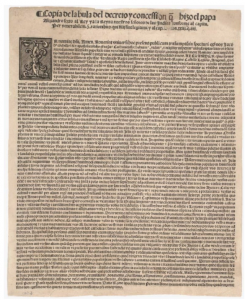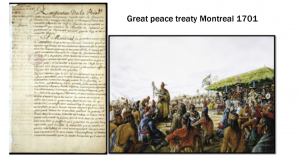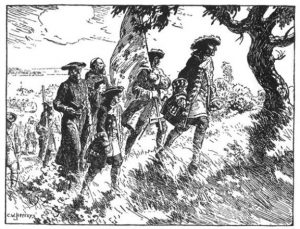Week 9: Anishnaabeg and Colonial Relationships, Effects of Colonialism Part 1
Colonialism in North America begins with the Papal Bull Inter Caetera issued by Pope Alexander VI in 1493 CE.[1] In 1492 Christopher Columbus landed on an island in the Caribbean he named San Salvadore. The following year, this bull was issued, giving Spain the exclusive right to discover lands 100 leagues west of the Azores and Cape Verde Islands. Discovery included the right to claim, exert sovereignty over and exploit any lands not inhabited by Christians. The Doctrine of Discovery flowed out of this bull. Portugal, England, France and Holland would use this doctrine to justify their colonizing enterprises.

Pope Alexander issued this Doctrine of Discovery on the authority invested by God in him as the Vicar of Christ on earth. It authorized colonizing nations to possess other lands and placed the responsibility of bringing them to the faith.
The Doctrine of Discovery is the foundation of all European claims in North America and American westward expansion. In1823, the United States Supreme Court, in the case Johnson vs M’Intosh, held in a unanimous decision “that the principle of discovery gave European nations an absolute right to New World lands.” The Canadian Supreme Court relied upon Johnson v. M’Intosh in such cases as St. Catherines Milling and Lumber Company v. The Queen, codifying the Doctrine of Discovery in Canadian Law. These cases reduce indigenous claims to their land to the right to occupy and use only. The colonial powers can extinguish these rights. Today, the Doctrine of Discovery remains the ‘Law of the Land’ in North America. The Doctrine of Terra Nullius was another doctrine of colonization that arose in the eighteenth century. Terra Nullius means ‘nobodies land.’ Captain Cook used this doctrine in 1770 when he claimed the eastern coast of Australia. Britain used Terra Nullius primarily in their efforts in the Pacific.
Listening Assignment 1
https://www.uua.org/racial-justice/dod/what-doctrine-discovery
French Regime in North America
Viewing Assignment 1
Samuel de Champlain
The French regime in North America began with the founding of Quebec in 1608 CE by Samuel de Champlain. In 1609 the French trading partners and allies, the Montagnais, Algonquin and Huron, asked Champlain to accompany them on a foray into their old enemies, the Mohawk’s lands. They moved up the Richelieu River into Lake Champlain, where they met a large force of Mohawk warriors.
The two groups faced off, and Champlain and a few French soldiers stepped out from behind the Algonquin warriors. The Mohawks had not seen Europeans before and were amazed at their steel breastplates, helmets adorned with large ostrich feathers. The French raised the arquebuses and fired, killing some Mohawk chiefs. The Mohawk broke ranks and fled in terror. After the victory, they returned down the Richelieu to Quebec. The Haudenosaunee became bitter enemies of the French after this incident.
In 1615 Champlain was on an expedition to Huronia when he encountered a hunting party of Algonkian-speaking people. He named them Cheveux relevés[2] or ‘High Hairs’ because of the way they combed their hair. These were Anishnaabeg or Ojibwe people who lived near the mouth of the French River. He gave their chief a hatchet as a gift which the leader admired greatly. The French gave gifts as a sign of respect. This act of diplomacy served to make friends rather than enemies.
Viewing Assignment 2
The Beaver Wars 1635-49 CE
In the first half of the 17th century, three Iroquoian-speaking nations occupied the area north of the Lower Great Lakes. They were the Tionontoti, the Ouendat and the Atawandaron. The Tionontoti lived along the southwestern shore of Georgian Bay, and the French called the Petun from an old French word meaning tobacco. They cultivated large fields of tobacco for trading purposes. They were also known as the Tobacco Nation.
The Ouendat lived to the east of the Tionontoti from the southern shore of Georgian Bay to the north shore of Lake Ontario. The French called them Huron from a French word meaning ‘ruffian.’ The Atawandaron lived along the north shore of Lake Erie from Niagara to Lake Huron. The French referred to them as the Neutral Nation because they generally remained neutral during skirmishes between the Ouendat and the Haudenosaunee or the Five Nation League of Iroquois.
The Huron were trading partners with the French and acted as middlemen for the Tionontoti and Atawandaron. The French had a policy of not dealing firearms with them. An individual could acquire a gun if he converted to Catholicism and proved himself faithful by remaining a Christian for some length of time. This policy left the three Ontario-Iroquoian nations quite vulnerable.
The Haudenosaunee traded with the Dutch at Orange, and the Dutch had no such policy. So, the Iroquois were very well-armed. However, after twenty years of trade, their beaver hunting grounds south of Lake Ontario had become depleted. In 1635 they started hunting sortes north of the lower Great Lakes, which caused significant friction between the Ontario Iroquoian-speaking people and the Haudenosaunee.
In 1639-40 the Huron were struck with an epidemic of smallpox. It spread to the Petun and the Atawandaron. The epidemic was severe and caused a famine because many were too sick to work the fields. The Haudenosaunee took advantage of the situation, increasing their attacks’ number and intensity. The plague, coupled with the imbalance of firepower due to colonial trade policies, spelled the end of the three Ontario nations. The circumstances reduced the population to about two thousand by 1649. They fled first to Christian Island, staying there one year, then the converted returned to Quebec with the Black Robes, and the traditionalists fled north to seek refuge with their Anishnaabeg trading partners. They created a palisaded town at Michilimackinac, where they became known as the Wyandotte.
Viewing Assignment 3
Reading Assignment 1
Reading Assignment 2
The Iroquois War 1700-01
After the destruction of the Ontario Iroquoian nations, the Haudenosaunee began occupying the lands north of the lower Great Lakes. The Seneca took the old Atawandaron lands north of Lake Erie while the Mohawks occupied the remainder. They solidified their presence over the next five decades by constructing towns throughout.
The last half of the 17th century brought much conflict for the Ojibwe to the north. Many skirmishes took place, followed by broken peace treaties. Finally, at the end of the century, the Three Fires Confederacy (Ojibwe, Odawa and Potawatomie) determined a war of expulsion.
Viewing Assignment 4
The Great Peace Treaty 1701
The war between the Haudenosaunee and the Three Fires Confederacy was not the only conflict happening in the Great Lakes Basin. The western Ojibwe were at war with the Sioux, The Fox and Sauk were fighting with the Ho-chunk and Menomonie. All this conflict caused significant detriment to the fur trade. Governor Louis-Hector de Callière called for peace talks in Montreal in 1701. Some thirteen-hundred delegates from thirty-nine nations gathered for the peace conference in the summer.

The various nations made many agreements both amongst themselves and with the French. Dish-With-One-Spoon wampum belts ratified them. For example, the Three Fires Confederacy sealed a deal with the Seneca with these words. An Odawa Chief spoke for the Three Fires. “Remember that when we will meet with them [the Five Nations] in the hunting grounds, that we regard them as our brothers and as our children. We have a long-life obligation to them to be henceforth of the same kettle.” ~ Hassaki, Kiskakon Odawa.
A Seneca Chief replied, “I would like that the land would be united and that the kettle was whole.” ~ Tekaneot, Seneca[3]
These treaties ended the French and Iroquois Wars and the other conflicts between indigenous First Nations.
Interactive Assignment 1
Founding of Detroit 1701

The Great Peace Treaty also allowed for the founding of Detroit. It was called Fort Ponchartrain, and it was initially a trading post where all First Nation trading partners could bring their pelts. Antoine de la Mothe Cadillac introduced the idea to his superiors to save the time and effort of voyageurs taking the trade to the interior. King Louis XIV permitted him to found Fort Ponchartrain on the banks of le Detroit. Cadillac sent out invitations to all France’s trading partners to come and live near the fort. Many did, but various nations were former enemies. Trouble flared up in 1706 between the Odawa and Miami. Skirmishes between the two lasted several months until the Odawa inadvertently killed a soldier and a Recollect priest or Grey Robe in front of the fort’s gates. Finally, the combatants retired from the area and returned to their homelands.
In 1712 skirmishes between the Odawa and the Fox led to a siege of the Fox village. The Odawa had returned to de troit. Cadillac had invited the Fox to move to de troit, which they did with more than one thousand men, women and children. The siege lasted several months.
Finally, the Fox fled during a rainstorm. The Odawa and their Ojibwe allies caught them at Grosse Point on Lake St. Clair. The Fox set up ramparts to defend themselves, but their enemies overran them. Over one thousand Fox men, women and children were killed.
Viewing Assignment 5
View this short video on Antoine de la Mothe Cadillac
The French and Indian War 1754-60
Braddock’s Defeat and Fort William Henry
Excerpt from David D Plain, The Plains of Aamjiwnaang, Trafford Publishing: Victoria, B.C. 2007 pp 27-30
The Plains of Aamjiwnaang 27
In the summer of 1754 at our defence of Fort Duquesne the Ahnishenahbek were credited for death of Major General Edward Braddock and the utter defeat of his army. He had been sent to the colony from England to especially expel the French from the disputed territory. He was fresh from victories in Europe, was a master tactician, and a stern by-the-book disciplinarian. However, his ego and overconfidence would not allow him to adjust conventional tactics to changing conditions. In short he did not appreciate forest warfare or the tenacity of the Ahnishenahbek. When Benjamin Franklin warned him not to discount the First Nations he replied, “These savages may, indeed, be a formidable enemy to your raw American militia, but upon the King’s regular and disciplined troops, sir, it is
28 David D Plain
impossible that they should make an impression.” 21
The British were advancing in a long column on the fort with a vastly superior force. General Braddock commanded fifteen hundred soldiers and thirteen pieces of artillery. George Washington, the young Major of the Virginia Volunteers who we defeated at Fort Necessity the previous year, had temporarily resigned his commission of Lieutenant Colonel to act as Braddock’s aide-de-camp. According to Parkman, Washington had two horses shot out from under him in the ensuing encounter and bullets tore his uniform on four separate occasions (a seemingly embellishment designed to romanticize the future American first president).22 Henry Gladwin, who would later defend Detroit against Pontiac, was also wounded in the rout. Another young teamster and blacksmith would escape that day by unhitching one of his horses and bolting straight for his father’s farm. He would go on later to find fame as the and “Indian fighter” from Kentucky, Daniel Boone.
We had 637 warriors mostly Ahnishenahbek. Langlade came from Michilimackinac and as was his practice would have recruited warriors from Askunessippi (Thames River), Saginaw as well as St. Clair whose war chief was Little Thunder. It is reputed that Pontiac was also with us leading the Otahwah from Detroit. There was also a small contingent of French with us, 72 Marines and 146 Canadians. The Canadians were mostly boys and fled when the conflict began. We met at the Monoghela River and attacked the two thousand yard long column from both sides firing from behind trees, thickets, rocks, fallen logs and gullies. Some of the British regulars
21 Richard H. Dillon, North American Indian Wars (London: Bison Books
Ltd., 1994) 36.
22 Francis Parkman, Montcalm and Wolfe (New York: Da Cappo Press Inc.,
1995), 128.
The Plains of Aamjiwnaang 29
claimed they did not see one of their enemies all day. All they saw were powder flashes and puffs of smoke and so that day the British shot a lot of trees. In a little while the column broke, panic set in and the Red Coats began a pell-mell retreat in total disarray. The British losses were staggering. Braddock was killed and the British lost 977 killed or wounded. We lost only twentythree.23
The western First Nations flocked to the side of the French after Montcalm destroyed Fort Oswego so easily and so decisively in 1756. We gathered in huge numbers at Ticonderoga to support Montcalm in his capture of Fort William Henry. Enumerations reported warriors from some forty-one First Nations totalling 1,779 combatants.24 This of course include Ahnishenahbek. We were allies with the French who had become our major trading partner so we received no soldier’s pay. Instead we were paid for the numbers of enemy killed or taken prisoner and by plunder. This was a time-honoured practice, which went a long way in supporting our war effort.
The Marquis de Montcalm was a scholar/soldier so when Fort William Henry capitulated he followed European military etiquette instead of honouring the longstanding arrangement between New France and its First Nation allies. He promised the British a safe conduct back to Fort Edward. They were to be allowed to march out under French guard with the honours of war, which included keeping their unloaded muskets withthem as well as all their baggage. The English also took Montcalm’s advice and stove their rum-barrels. All this left little plunder and infuriated the Marquis’ First Nation allies so we took matters into our own hands.
23 Schmalz, Ojibwa, 49.
24 Parkman, Montcalm, 282-283
30 David D Plain
To receive the remuneration due, we attacked the long column of British regulars and their colonial militia, who were being escorted by 300 French regulars. After the debacle caused by Montcalm’s lack of understanding of the importance of our rules of engagement, we abandoned him in great numbers. We left Lake George, proceeding straight to Montreal with our compensation, including two hundred prisoners.
The governor rebuked us for breaking the capitulation, but the rebuke rang hollow. Colonel Bougainville thought our prisoners of war should have been taken from us, and we should have been sent home in disgrace. Instead, we were paid the price of two kegs of brandy for each prisoner’s release. We were also given guns, canoes and other presents before leaving Montreal. The Intendant Bigot was so fearful of our strength that he added in his report, “they must be sent home satisfied at all costs.”25 Although the French won the battle at Fort William Henry, they also lost the war there. The history books teach that France lost the continent on the Plains of Abraham, but that was only a last gasp. Montcalm really lost the continent at Fort William Henry.
25 Ibid., 305.
Viewing Assignment 6
The Braddock Expedition
Viewing Assignment 7
The Battle of Fort William Henry 1757
Questions
1. What document made colonialism moral and legal?
2. How did it do this?
3. What event drove the Mohawks to become allies first with the Dutch, then the British?
4. Which French policy gave the Iroquois the advantage over the Huron and allies?
5. Which event changed the trade dynamic between the French and their indigenous allies?
6. How did it do this?
7. What caused the French to lose the support of their indigenous allies during the French and Indian War?
[1] Read the full transcript of Inter Caetera here https://www.gilderlehrman.org/sites/default/files/inline-pdfs/T-04093.pdf last viewed January 3, 2022.
[2] Champlain, Samuel de Works, vol. 3, ed. H.P. Biggar. Toronto, 1922-36, p43-44.
[3] Lytwyn, Victor P A Dish with One Spoon: The Shared Hunting Grounds Agreement in the Great Lakes and St. Lawrence Valley Region, p 8-9 https://ojs.library.carleton.ca/index.php/ALGQP/article/view/507/409 last viewed 17-January-2022.

